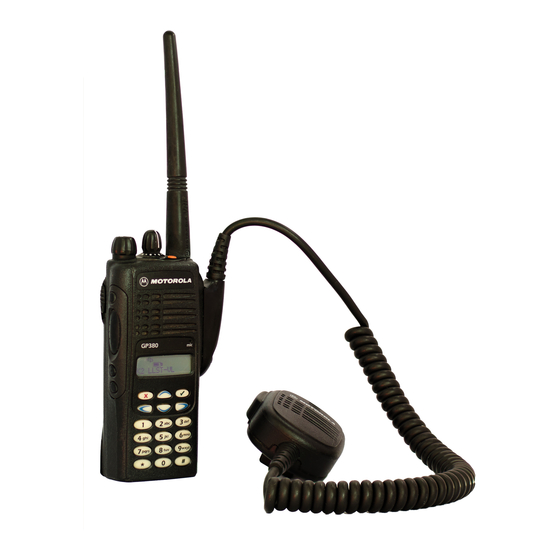Motorola GP series Service-Handbuch - Seite 18
Blättern Sie online oder laden Sie pdf Service-Handbuch für Radio Motorola GP series herunter. Motorola GP series 26 Seiten. Professional radio
Auch für Motorola GP series: Informationen zum Dienst (24 seiten), Informationen zum Dienst (31 seiten), Informationen zum Dienst (43 seiten), Informationen zum Dienst (30 seiten), Benutzerhandbuch (16 seiten), Handbuch (30 seiten)

2-2
to hasten the drying process since this could cause the liquid to collect in unwanted
places. Upon completion of the cleaning process, use a soft, absorbent, lintless cloth to
dry the area. Do not brush or apply any isopropyl alcohol to the frame, front cover, or
back cover.
NOTE
Always use a fresh supply of alcohol and a clean container to prevent contamination by
dissolved material (from previous usage).
3.0
Safe Handling of CMOS and LDMOS
Complementary metal-oxide semiconductor (CMOS) devices are used in this family of radios.
CMOS characteristics make them susceptible to damage by electrostatic or high voltage charges.
Damage can be latent, resulting in failures occurring weeks or months later. Therefore, special
precautions must be taken to prevent device damage during disassembly, troubleshooting, and
repair.
Handling precautions are mandatory for CMOS circuits and are especially important in low humidity
conditions. DO NOT attempt to disassemble the radio without first referring to the CMOS CAUTION
paragraph in the Disassembly and Reassembly section of the manual.
4.0
General Repair Procedures and Techniques
Parts Replacement and Substitution
When damaged parts are replaced, identical parts should be used. If the identical replacement
component is not locally available, check the parts list for the proper Motorola part number and
order the component from the nearest Motorola Communications parts center listed in the "Piece
Parts" section of this manual.
Rigid Circuit Boards
The family of radios uses bonded, multi-layer, printed circuit boards. Since the inner layers are not
accessible, some special considerations are required when soldering and unsoldering components.
The through-plated holes may interconnect multiple layers of the printed circuit. Therefore, care
should be exercised to avoid pulling the plated circuit out of the hole.
When soldering near the 20-pin and 40-pin connectors:
❏
avoid accidentally getting solder in the connector.
❏
be careful not to form solder bridges between the connector pins
❏
closely examine your work for shorts due to solder bridges.
Flexible Circuits
The flexible circuits are made from a different material than the rigid boards and different techniques
must be used when soldering. Excessive prolonged heat on the flexible circuit can damage the
material. Avoid excessive heat and excessive bending.
For parts replacement, use the ST-1087 Temperature-Controlled Solder Station with a 600-700
degree tip, and use small diameter solder such as ST-633. The smaller size solder will melt faster
and require less heat to be applied to the circuit.
MAINTENANCE
